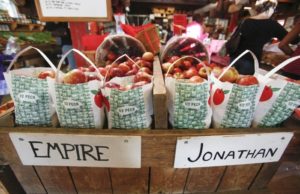It’s About Time
by Gary Mount
 In today’s fast-moving world, it may seem strange to think of the importance of time in apple growing. After all, the apple just sits on the tree and waits to be picked, right? Well, not exactly. Starting in the spring when the apples bloom, the fruit grower must keep track of time.
In today’s fast-moving world, it may seem strange to think of the importance of time in apple growing. After all, the apple just sits on the tree and waits to be picked, right? Well, not exactly. Starting in the spring when the apples bloom, the fruit grower must keep track of time.
Each apple variety takes a particular amount of time from bloom to harvest. Year after year, it doesn’t change very much. Some of the earliest apples take only 70 days to mature, like the Lodi variety, a green cooking apple normally picked in early July. Add a bit more time and apples such as Gala (135 days) and McIntosh (140 days) are ready. Still later are Stayman Winesap and Rome Beauty (165 day) even though they flowered and started growing about the same time as the others in the spring.
Why is a fruit grower interested in all this time? Harvesting apples is the most time-important part of the yearly work of fruit growing. If picked too early, even by a few days, apples have not started the ripening process and stay green and tasteless inside. If picked too late, even by a few days, the ripening process is too far advanced, the apples quickly become soft, will not store well in cold storage and definitely will not please consumers.
Apple growers use other methods to determine the right “time” to pick. Sample apples are cut in half and wetted with an iodine solution, which shows the starch versus sugar content of the apple. Half starch and half sugar is about right. Growers also use a device to measure the sugar percentage of the apple. A “brix”, as it is called, of 9 or 10 means the apple needs more time on the tree. A reading of 14 to 15 is ready to be picked.
Finally, the grower physically measures the firmness of the apple flesh. While a range of 13 to 18 lbs firmness is acceptable to the consumer, only the upper levels will store well. The lower firmness indicates the apple has had too much time on the tree and is ripening rapidly.
The true “final” measurement is to taste the apple, our oldest and most enjoyable fruit. When it is picked and ready to eat, it’s about time.
